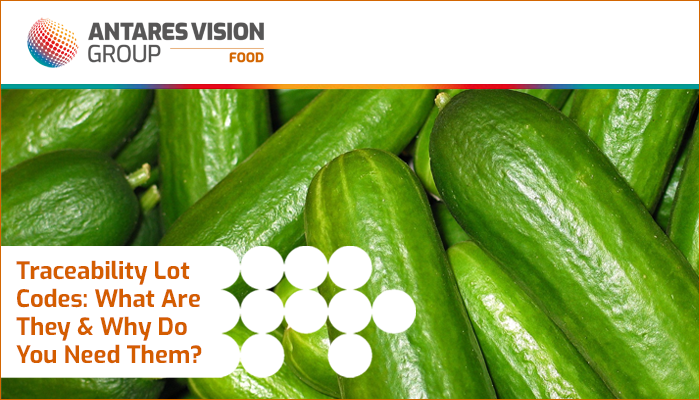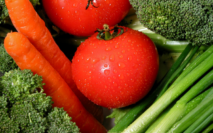Traceability lot codes are small but mighty tools that help to ensure food safety. Today, we’re going to look at traceability lot codes, including how they promote safety in the food industry and the important role they play in the Food Safety Modernization Act (FMSA) Section 204 compliance and securing public health.
What Is a Lot Code?
A lot code is essentially a passport for food products. It’s a unique identifier, usually a sequence of numbers and letters, that identifies a specific batch of products that were manufactured (or harvested) under the same conditions and in the same location. Lot codes help track products through the entire supply chain and are vital for troubleshooting quality issues and speeding recalls. Lot codes are assigned to products by the manufacturer.
Whether it’s a pallet loaded with cases of olive oil, a box of cereal, or even a raw agricultural commodity (RAC), the lot code tells you where an item came from and when it was made. This is vital for traceability, helping manufacturers and regulators such as the FDA and USDA keep tabs on products as they move from field to factory to consumers.
Using lot codes not only helps food companies comply with traceability and food safety regulations — they also promote supply chain transparency as part of an indelible provenance that tells where a food came from, who handled it (e.g., harvesters, packers, shippers, and receivers), and its expiration date.
How to Read a Lot Code on a Product
Typically, a lot code includes information about the production date, batch number, and sometimes even the manufacturing line. For instance, a lot code reading “20210305” could mean the product was manufactured on March 5, 2021. If it says “2021030515,” it could mean the product’s expiration date is March 15, 2021. Other numbers can indicate a unique product ID or the name of the grower, producer, or manufacturer.
Role of Lot Codes in Traceability
In the journey from farm to fork, lot codes act like breadcrumbs. They enable traceability at every step, from production to first land-based receiving interactions and beyond. If there is a foodborne illness outbreak or other problem, stakeholders can trace goods back to their sources.
And as we said above, they help you comply with food regulations, including the Food Safety Modernization Act (FSMA), which mandates recordkeeping and traceability requirements for certain foods. More on that below.
Ensuring Food Safety Through Lot Codes
Traceability lot code requirements, such as those in FSMA 204, promote better food safety and transparency across the supply chain. One of the biggest benefits of traceability lot codes is that they help companies and investigators quickly pinpoint the origins of foodborne illnesses.
If an issue occurs with one of your products, you can quickly determine which products have been affected and where they are in your supply chain or, if they’ve reached their final destination, what retail establishment they’re in. With this granular data, you can implement a focused recall strategy that protects consumers and public health while minimizing product loss. Such precision also helps protect your brand: You can communicate with consumers about the status of the recall, affected areas, and how to dispose of the recalled product.
Common Questions About Traceability Lot Codes
Let’s consider a few common questions about traceability lot codes.
Can a Lot Code Tell You Whether a Product Is Organic or Not?
Lot codes don’t directly convey this information; however, they can be used alongside other product details to let consumers know if a product is organic.
How Can Consumers Use Lot Codes?
Consumers can use lot codes to make informed decisions about the food they buy. They can check the lot code to determine whether their product is part of a recall. It’s also a handy way to gauge a product’s freshness.
Why Are Lot Codes Important for Food Safety?
Lot codes make tracking and tracing products faster, easier, and more accurate. If there’s a problem with a food item, such as a contamination issue, the codes help quickly identify which products are affected.
Consumer Awareness and Lot Codes
If you want to establish your brand as transparent and customer-centric, you should educate consumers about traceability lot codes. Teaching consumers how to read codes and learn what information they provide will empower them to make informed choices regarding the food products they buy.
The FSMA Traceability Lot Code
The Food and Drug Administration’s (FDA) Food Safety and Modernization Act (FSMA) is the primary set of regulatory requirements governing the use of a lot code on food products. FSMA rules outline when to put a lot code on food products, what traceability data you must retain, and more.
The FDA Food Safety Modernization Act requires you to track key data elements (KDEs) and critical tracking events (CTEs) for certain foods like shell eggs, butter, tree-borne fruits, and more. The final rule’s requirements have a compliance date of January 20, 2026. However, some aspects are already being enforced.
What is the FSMA Traceability Lot Code?
The FDA defines the FSMA traceability lot code as “a descriptor, often alphanumeric, used to uniquely identify a traceability lot within the records of the firm that assigned the traceability lot code.”
Certain types of companies must assign, record, and share with their trading partners the traceability lot codes for foods on the FTL. These companies must also link the codes to information that identifies FTL foods as they move through the supply chain. (More on this below.)
A traceability lot code must be assigned when any of the following occur:
- Initial packing of a raw agricultural commodity (RAC*), other than a food obtained from a fishing vessel
- Performing the first land-based receiving of a food obtained from a fishing vessel
- Transformation of a food
Section 201(r) of the Federal Food, Drug, and Cosmetic Act defines a RAC as “any food in its raw or natural state, including all fruits that are washed, colored, or otherwise treated in their unpeeled natural form prior to marketing.”
FSMA Traceability Lot Codes in Action: CTEs and KDEs
To fully understand FSMA traceability lot codes, we have to talk about the cornerstones of FSMA traceability: critical tracking events (CTEs) and key data elements (KDEs), which are required for foods on the FTL.
In broad terms:
- CTEs include events that happen during growing and processing, such as harvesting, cooling, initial packing, and distribution.
- KDEs provide the granular details for food traceability, including time, location, unit measurements, and information about the businesses handling the food.
- Different companies are responsible for different types of KDEs (e.g., for receiving, shipping, transformation).
A FSMA traceability lot code is typically assigned during the “initial packing” CTE, which the law describes as “packing a RAC, other than a food obtained from a fishing vessel, for the first time.” This means that a code is not assigned at previous supply chain nodes, such on a farm, during harvest, or at a cooling facility.
Once a traceability lot code has been assigned, the records required at each CTE must include that code. Furthermore, companies shouldn’t change the traceability lot code they receive from their partners (e.g., a shipper shouldn’t change the code it receives from an initial packager).
Do You Have to Comply? Are You Exempt?
The Final Rule does have exceptions to the requirements we’ve discussed above.
Overall, the law stipulates that “persons who manufacture, process, pack, or hold foods on the FTL [must] maintain records containing KDEs associated with CTEs” and “provide information to the FDA within 24 hours or within some reasonable time to which the FDA has agreed.”
Therefore, speaking generally, initial packagers, shippers, and receivers have to assign, record, and/or share include a FSMA traceability lot code. Companies that transform FTL foods into other products must include the traceability lot code for each ingredient received and a new traceability lot code for the product you’ve created.
However, companies that receive an FTL food from a partner that is exempt from the regulations must assign a traceability lot code if one has not already been assigned — unless the receiving company is a retail food establishment or a restaurant.
Again, we’re speaking generally. The FDA has an online tool to determine if you’re exempt from the Final Rule.
Final Thoughts About Traceability Lot Codes
This is a lot of information to digest, especially the FSMA requirements. The best option is to contact us and nail down your FSMA traceability lot code obligations — and to make sure you’re ready to comply with every FSMA requirement.
As we wrote in our last FSMA update about two weeks ago, the deadline to comply is January 20, 2026. That seems like a long way off, but it’s really not when you factor in the complexity of the Final Rule, the FTL, and the other mandates.
Antares Vision Group can help. We’ll answer your questions. We’ll demonstrate how our traceability and compliance solutions meet your exact needs. And we’ll show you how technology from rfxcel brings added value for brand protection, risk mitigation, customer engagement. Drop us a line today and let’s get started.
Read More About FSMA:
- Download our new white paper: Traceability in the Food Supply Chain
- FSMA Traceability: What the Food Industry Needs to Know Today
- FSMA Traceability Requirements: FDA Guidance & GS1 Standards
- FSMA 204 Data Carrier: FDA Guidance and GS1 Standards





